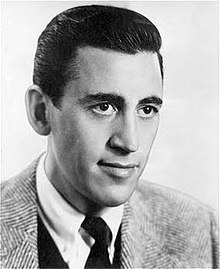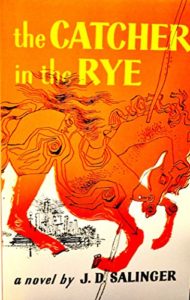Prosegue la collaborazione fra il Liceo Linguistico “Cattaneo-Dall’Aglio” e Redacon.
"Speakeasy", una rubrica curata dagli studenti.
The catcher in the rye: adolescence vs. adulthood

The Catcher in the Rye is a character-forming novel by J.D. Salinger, an author whose centenary is celebrated this year, which is set around the fifties. It is narrated by Holden Caulfield, a sixteen-year-old boy who tries to escape from the hypocrisy and responsibilities of the adult world.
As written in the daily newspaper La Repubblica, Holden is the prototype of a young man whose teenage anxieties can last throughout his life. The way he judges and abhors the adults, often calling them phonies or bastards, makes us understand the difficulties of the author in conforming to social life. In fact, while Holden gets himself expelled as a sign of “rebellion”, J.D. Salinger drifted away and disappeared from the literary world in 1965. So much so that in a recent interview to The Guardian Salinger’s son has said his father kept writing for 50 years without publishing, which makes us hope there will be more by the writer published in the coming years.
This rejection of adjustment to society is clearly explained in an article of The New York Times. Studies reveal that during adolescence our brain is highly influenced by experience and, as a result, exposing ourselves to the social world can be traumatic. Growing up means facing challenges and making choices, but, luckily, at that age our brain is sensitive enough to deal with stressful events: an adolescent brain is more likely to profit from enriching experiences. Thus a prolonged adolescence might even be worthwhile, since it would allow us to face challenges with a more open mind.

Nevertheless, in the case of Holden Caulfield, he refuses to take his responsibilities and he alienates himself as a form of self-protection. He feels he doesn’t belong to adulthood and wants to delay his growth.
The title of the novel is based on the lyric by Robert Burns Comin’ Thro’ the Rye which says “If a body meet a body, coming through the rye”. However, Holden replaces the word “meet” with the word “catch” and he thinks of himself as the catcher in the rye, the one who protects innocent children from their “fall” into adulthood.
Nowadays adolescence is an everyday topic, with its steady alternation of ups and downs; it’s the first approach to the world outside, as well as the period in which you begin to shape your own personality and your own ideas.
Carefreeness, curiosity and desire for discovery make adolescence an age of wonderful experiences and strong emotions, which fleshes out the best memories we will forever keep within ourselves. An age where all is fair, where love, happiness and euphoria mix together with moments of sadness and confusion.
As teenagers, we can understand Holden’s sensitivity towards the transition from adolescence to adulthood, but we also believe that, at some point, everyone should take their responsibilities and deal with life changes.
Fonti:
- La Repubblica “Salinger e ‘Il giovane Holden’: le ansie assolute della giovinezza nel romanzo icona del Novecento” (Gen 2019)
- The Guardian “JD Salinger’s unseen writings to be published, family confirms” (Feb 2019)
- The New York Times “The case for delayed adulthood” (Sep 2014)
Giulia Dallari, Martina Rinaldi, Giorgia Serafini (Classe 5ªQ Liceo Linguistico)
Traduzione

The Catcher in the Rye (in italiano Il Giovane Holden) è un romanzo di formazione scritto da J.D. Salinger, un autore del quale quest’anno si celebra il centenario, ambientato negli anni ‘50. È narrato da Holden Caulfield, un ragazzo di sedici anni che cerca di scappare dall'ipocrisia nonché dalle responsabilità del mondo adulto.
Come scritto nel quotidiano La Repubblica, Holden è il prototipo di un giovane uomo le cui paranoie adolescenziali rischiano di protrarsi durante il corso di tutta la sua vita.
Il modo in cui giudica e detesta gli adulti, spesso chiamandoli per esempio falsi o bastardi, lascia intendere le difficoltà riscontrate dall’autore nel relazionarsi con la società. Infatti, mentre Holden si fa espellere come segno di ribellione, J.D. Salinger si allontanò e scomparve dal mondo letterario nel 1965. Si isolò così tanto che, in una recente intervista del quotidiano The Guardian, il figlio di J.D. Salinger ha dichiarato che il padre ha continuato a scrivere per cinquant’anni senza pubblicare nulla. Questo ci fa sperare di poter leggere qualcosa di più dello scrittore nei prossimi anni.
Questo rifiuto di adattarsi alla società è spiegato con estrema chiarezza in un articolo di The New York Times.
Alcuni studi rivelano che nel periodo adolescenziale il nostro cervello è ampiamente influenzato dall’esperienza e, di conseguenza, esporsi in ambito sociale può essere, a primo impatto, traumatico. Crescere significa affrontare sfide e fare delle scelte, ma fortunatamente a quell’età il nostro cervello è abbastanza sensibile per riuscire ad affrontare lo stress e tende maggiormente a trarre beneficio da esperienze stimolanti. Pertanto, un’adolescenza prolungata può essere vantaggiosa dal momento che ci permette di affrontare le sfide con una mente più aperta.
Nonostante ciò, nel caso di Holden Caulfield, il ragazzo rifiuta di prendersi le proprie responsabilità e si isola come forma di difesa. Sente di non appartenere al mondo adulto e cerca di ritardare la propria crescita.
Il titolo del romanzo si basa sulla poesia di Robert Burns Coming thro’ the Rye il quale dice “If a body meets a body coming through the Rye” (se un corpo incontra un corpo che emerge dalla segale). Ma Holden sostituisce la parola “meet” (incontrare) con la parola “catch” (afferrare) e pensa a se stesso come a colui che protegge i bambini innocenti dalla loro “caduta” nel mondo adulto.

Al giorno d’oggi l’adolescenza è un tema di cui si discute quotidianamente: con i suoi alti e bassi rappresenta il primo vero approccio con il mondo esterno nonché il momento in cui iniziano a prendere forma la nostra personalità e le nostre idee.
Spensieratezza, curiosità e desiderio di scoprire rendono l’adolescenza un’età di meravigliose esperienze e forti emozioni, che costituiscono i ricordi più belli che porteremo con noi per sempre.
Un’età in cui tutto è permesso, in cui amore, felicità ed euforia si mescolano a momenti di tristezza e confusione.
In qualità di adolescenti, possiamo comprendere la sensibilità di Holden nei confronti del passaggio tra l’infanzia e il mondo degli adulti, ma crediamo anche che, ad un certo punto, ognuno di noi debba prendersi le proprie responsabilità e imparare gestire i cambiamenti della vita.
Giulia Dallari, Martina Rinaldi, Giorgia Serafini (Classe 5ªQ Liceo Linguistico).







